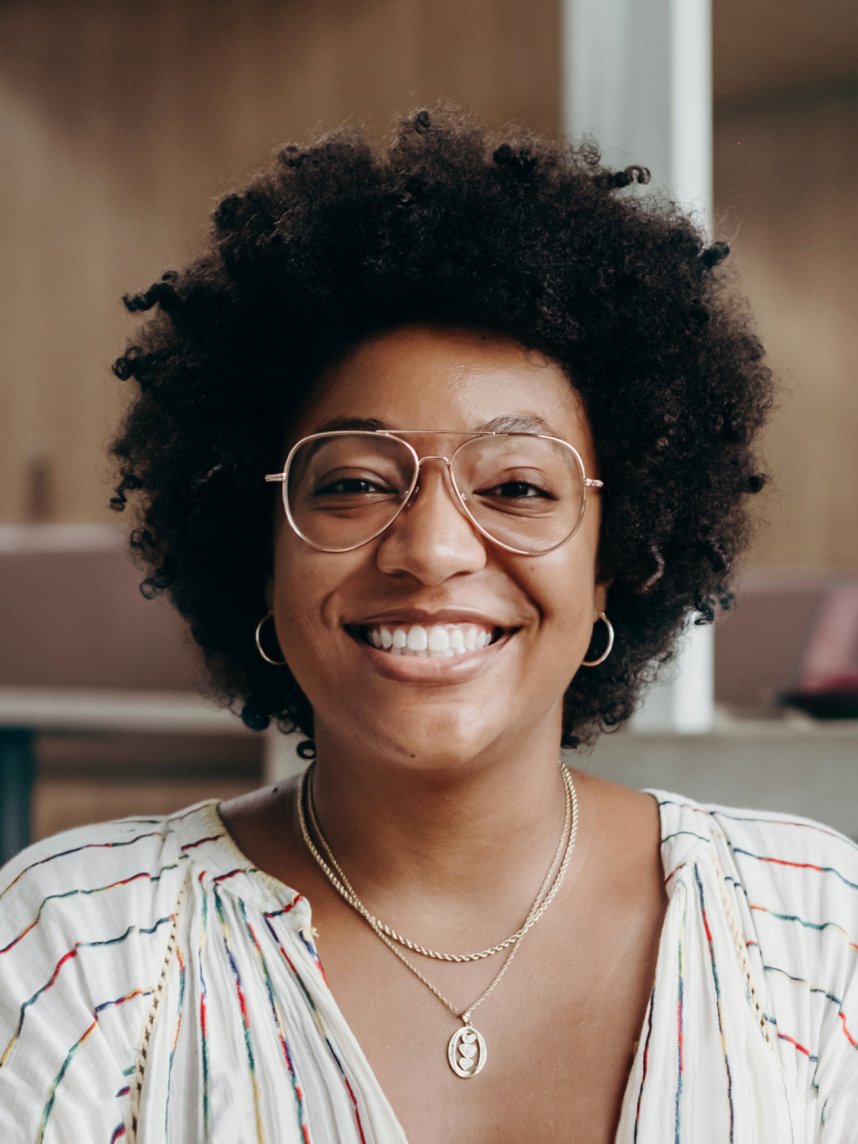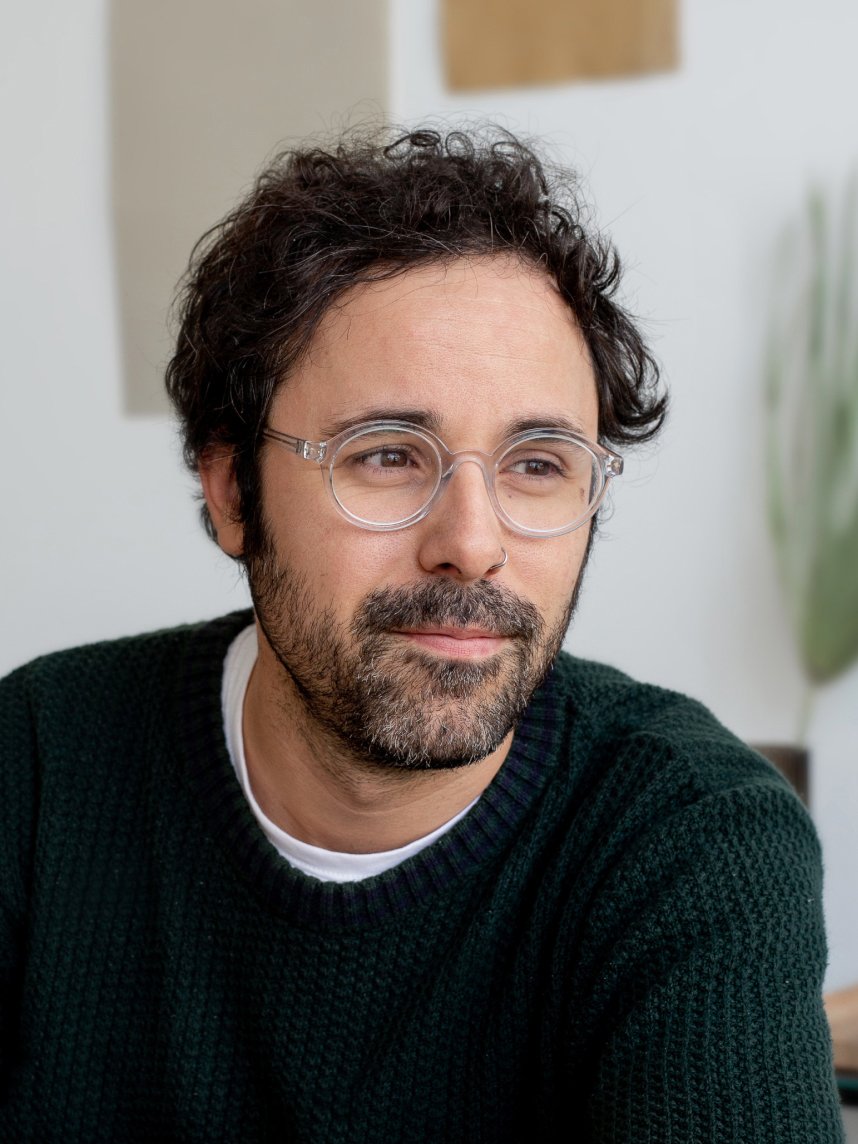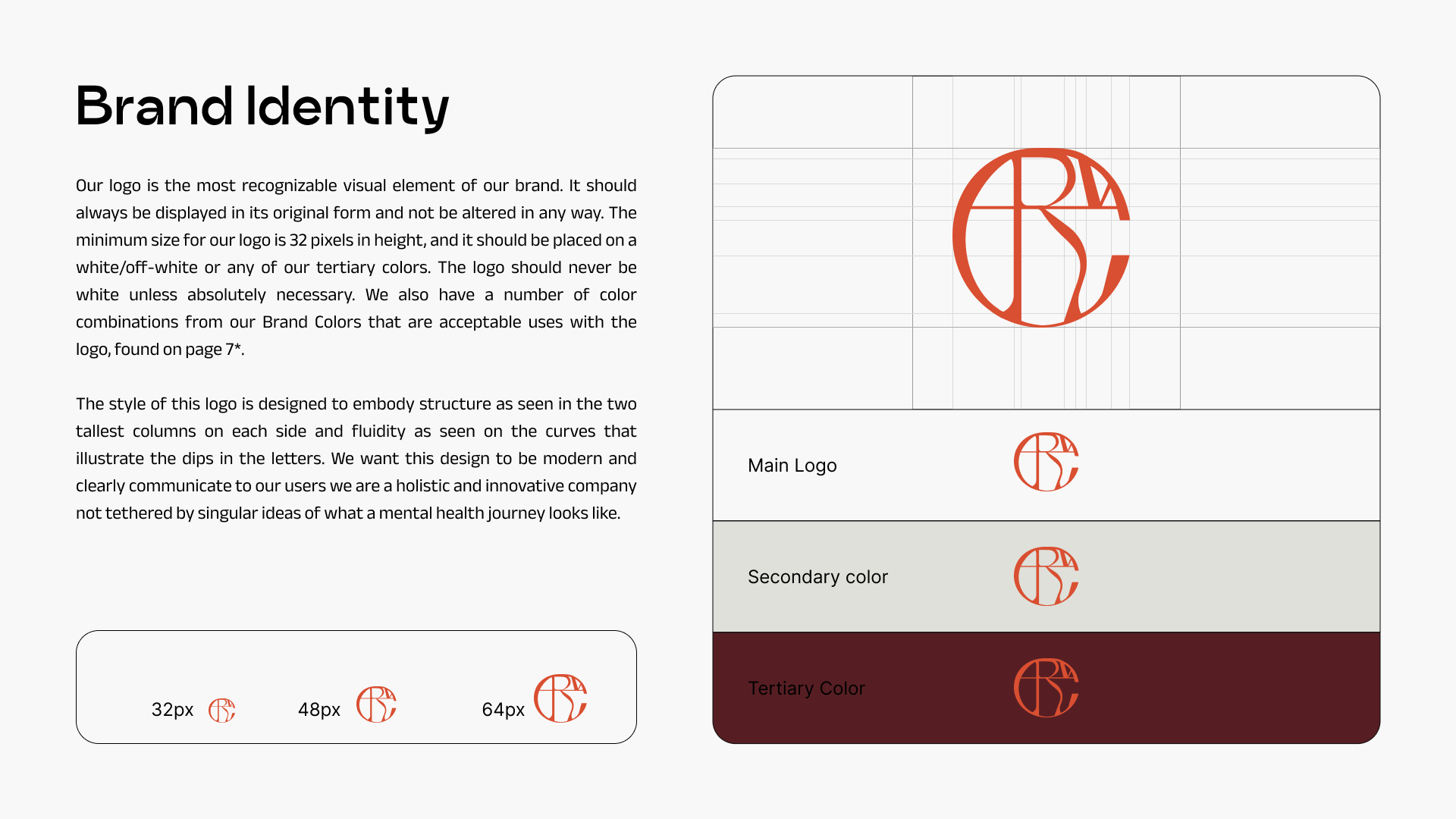
arcve
*
arcve *
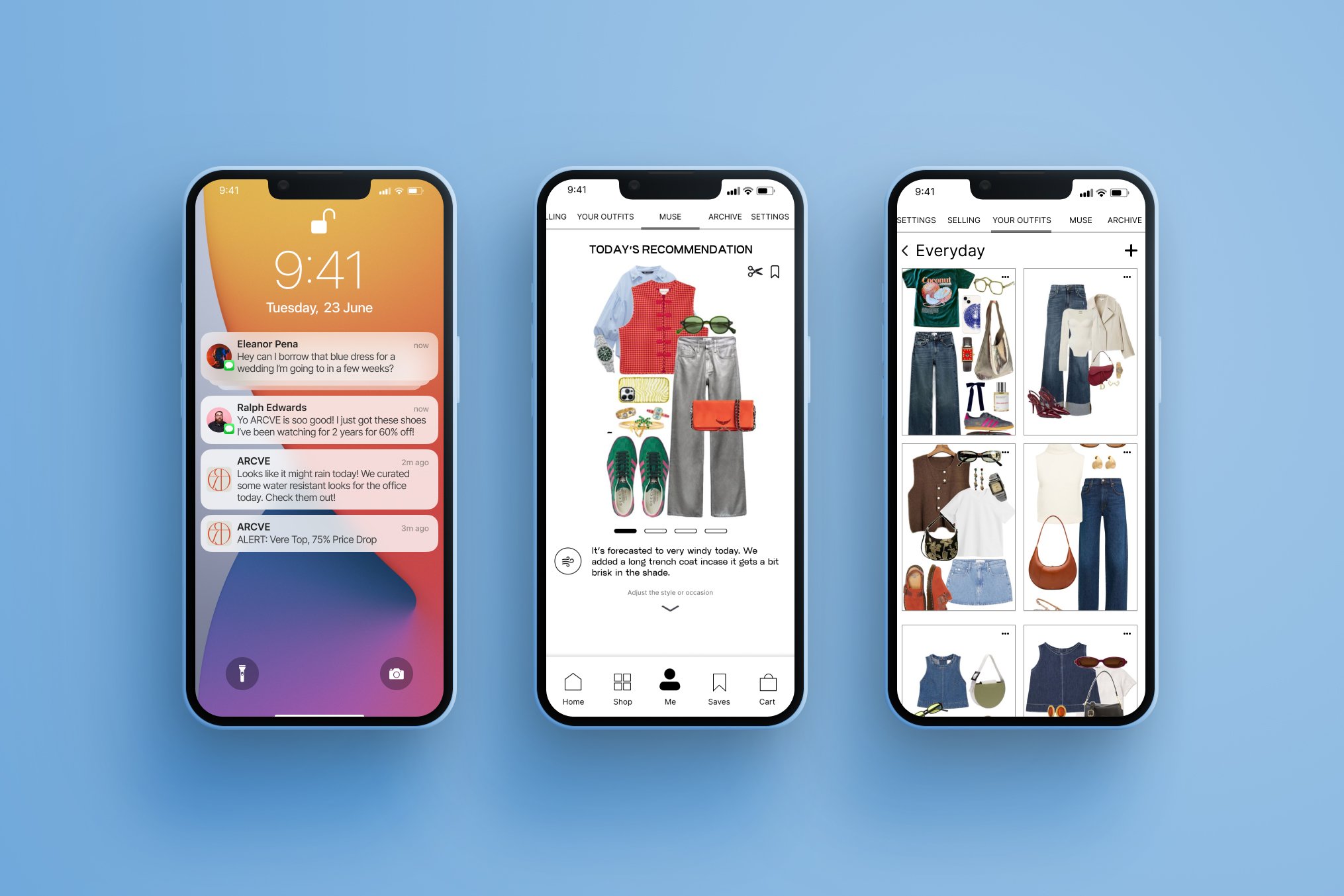
ARCVE
*
ARCVE *
ARCVE
Project: Digital Closet & Universal Shopping App
Context: Thesis Project
Role: UX/UI Designer & Researcher
Device: iOS & Android
Arcve is a digital closet app designed to help users rediscover, style, and shop their wardrobe with a more sustainable mindset. By digitizing their closet, users can create outfits, receive styling recommendations, and track what they own to make intentional, impactful wardrobe choices. With added capabilities, Arcve notifies users when items on their wish list come back in stock or go on sale, whether through retailers or secondhand platforms. This functionality not only helps users save time and money but also encourages sustainable habits, all in a single, seamless platform.
Designing for a need
The idea for Arcve was born
out of my own experience with wanting a more intentional approach to fashion.
Like many, I found myself frequently forgetting items in my closet, leading to repetitive purchases and missed opportunities to style what I already owned. I wanted a tool that could help me be more mindful about my wardrobe—making it easy to access everything at a glance, create outfits that fit my lifestyle, and stay up-to-date on pieces I’d been eyeing, all while supporting a more sustainable approach to fashion. Arcve became my solution to bridge these gaps, merging convenience with conscious consumption.
On average the number of times a person wears a certain clothing item is around 7-10 times before discarding it, which is not a lot
(Igini, 2023)
Research & Discovery
*
Research & Discovery *
65%
AIof US consumers are interested in purchasing sustainable clothing, but around 48% say they don't know where to find sustainable brands.
75%
Sustainability Preferences: About 75% of Gen Z shoppers report purchasing pre-owned clothes to reduce consumption. This demographic is increasingly prioritizing sustainability and eco-conscious brands
68%
of Vogue readers consider sustainability to be an important consideration when making fashion purchases, and 38% buy as much sustainable fashion as possible.
72%
of consumers are now aware of the sustainable fashion concerns and are making decisions based on a company's environmental impact.
80%
It's reported that 20% of our wardrobe being worn 80% of the time. Which is to say, 80% of what is in your wardrobe is not worn most of the time. This highlights the need for better wardrobe management and outfit planning
79.07%
Second-Hand Market Growth: The global second-hand fashion market was valued at $43 billion in 2022 and is projected to grow to over $77 billion by 2025. This suggests a rising interest in sustainable fashion choices, which your app can facilitate
The Market isn’t saturated.
The market growth is fueled by rising consumer awareness of sustainability, the affordability and accessibility of second-hand goods through online platforms, and a growing appreciation for unique items. Social media continues to influence this shift, as does a changing consumer mindset around ownership and consumption. Additionally, many buyers are turning to premium and luxury brands, not only for their durability but also for the high resale value that makes these items worthwhile, long-term investments.
↑16%
Accessibility of used goods platforms
With a remarkable annual growth rate of 16%, the market for used goods platforms is rapidly expanding as consumers increasingly embrace sustainable shopping options, making pre-owned items a popular alternative to new purchases. This trend highlights a strong shift towards conscious consumerism and the growing appeal of circular fashion.
↑46%
Eco-consumerism Marketing
Marketing efforts around eco-consumerism have surged by 46%, signaling a significant rise in both consumer interest and business investment in sustainable practices. This trend reflects a rapidly expanding demographic that prioritizes environmental impact in purchasing decisions, encouraging brands to align more closely with eco-conscious values.
Market Insights:
Consumer Trends Driving Sustainable Fashion and Closet Digitization
Through my research, I found that while multiple companies lead in areas like reselling, purchasing, and even product sustainability requirements, none effectively integrate comprehensive closet digitization and item tracking into their platforms. Leading platforms are strong in their distinct elements: some excel in sustainable product offerings, while others focus on resale, but they lack the cohesive features necessary to help users truly manage their wardrobes. The addition of closet digitization—enabling users to log their items, track usage, and design outfits—emerges as a critical, yet underrepresented feature in the market. This unique capability, alongside sustainable shopping and resale functions, could provide a holistic solution that not only meets user needs for convenience and environmental consciousness but also bridges the gap in the current market landscape.
Monet Goode
Monet Goode
Eleanor Parks
Eleanor Parks
Emmet Marsh
Emmet Marsh
User Persona
-
Age: 26
Occupation: Journalist
Location: Brooklyn, NY
Income: $87,000
Interests: Art, Fashion, Sustainability, and politics -
Is a determined, smart, and fun loving young woman living in NYC. She loves design and fashion and that definitely reflects in how she dresses, which is unique and stylish. However, due to her professional occupation she does tone it down most days.
-
Pain points: She hates to admit it, but thrifting has become too tedious and time consuming and shopping from unsustainable retailers just to buy clothes that fall apart the next year isn’t a good alternative. She wants to start developing a core collection of pieces that will serve her in the next 10 years.
-
I’d love a personal stylist! Someone who knows exactly what I have in my closet so they can help me make new outfits, remember successful ones I’ve worn before, and remind me of pieces I’ve forgotten.
-
Age: 34
Occupation: Product Manager
Location: Brooklyn, NY
Income: $187,000
Interests: Finance, Fashion, Sustainability, and tennis -
Is an incredibly sophisticated young man who is starting to settle down with his boy friend in Chicago. His love of design reflects in everything he does, from his unique style, projects, passions, and home. Even in a professional setting he never strays from showcasing who he is.
-
Since high school hes been investing in stellar vintage designer pieces, further developing his closet, however as a seller he finds that awareness is an issue for his buyers. Additionally he wants a good way of documenting his favorite outfits for future use.
-
I want a way to show people how to style the pieces they buy from me with their own wardrobe. Men’s fashion is intimidating for many when it doesn’t have to be.
-
Age: 21
Occupation: Student
Location: Seatle, WA
Income: $45,000
Interests: Fashion, Sustainability, and reality tv. -
Is a simple young woman who is keen on starting to explore the world. She loves fashion though she feels that her personal taste is quite developed yet. She finds shes easily influenced by TikTok and Instagram and wants to explore what she sees there, but everything can be so expensive. She doesn’t want to look like everyone else like Amazon influencers but also finds thrifting too time consuming. She’s lucky to have counsins who have encouraged her to use Depop before buying anything new, but sometimes its so hard to avoid Zara.
-
Wants to avoid dressing like everyone else — she wants to avoid using Amazon, Zara, and H&M but it can be so hard when she wants to explore her own taste and pursue a trend. She likes to use Depop but its risky to not try on the clothes first, especially with having wide hips and big thighs can make standard clothing measurements useless.
-
I want someone to tell me explicitly NO, when it comes to fast fashion. I want a platform that can help me find high quality pieces, not necessarily from high end designers, that I can buy for fair prices so I can ethically explore my style and pursue trends without feeling bad.
-
21/23 Users are aware of the negative environmental impact of fast fashion. Those same people struggle with avoiding fast fashion because of its convenience, leading to a desire for more sustainable and conscious consumption habits.
-
23/23 Users forget about items in their closets. 19/23 admit to over-purchasing and under-utilization of existing clothing.
-
19/23 Users did not care about quality or the clothing composition, rather if it suited their needs they would purchase. However, 23/23 users said if an item “looked or felt cheap” they would not purchase.
-
17/23 Users face difficulties in finding and tracking used goods due to limited availability and ineffective tools, complicating their impulse-buying habits. 6/23 Users do not actively participate in thrifting, only the rare purchase of vintage/designer goods.
-
15/23 Users feel influenced by trends, users need a way to pursue them sustainably, which includes closet documentation and recycling. 8/23 Users felt their individual taste do not align with most trends.
-
22/23 Users want assurance that the brands they support are eco-conscious and a good investment (for resale or longevity).
-
20/23 The desire to resell items is hindered by the fragmented nature of resale platforms, making it difficult to navigate multiple marketplaces.
-
5/23 Users follow items they are interested in. Those same users want a way to track an item when it appears, is discounted, or sells out.
-
18/23 Users get help from friends when styling themselves. 15/23 use Pinterest, Instagram, TikTok for fashion inspiration. 17/23 would like help styling, like a home personal stylist.
User pains.
In my user study, I interviewed 23 participants—11 in their 20s, 10 aged over 30, and 2 over 45—to explore their perspectives on fashion trends and personal dressing habits.
IDEATION *
DESIGN *
IDEATION * DESIGN *
Core features.
Based on my research, the focus will be on closet digitization, allowing users to curate and visualize their wardrobes like a mood board, while incorporating an
AI stylist that recommends new outfit combinations based on user-defined environmental factors. Additionally, the app will facilitate item tracking, encouraging users to pursue slow fashion by saving up for desired pieces and monitoring when they go on sale, thus alleviating the pressure to buy immediately. While shopping and reselling functionalities are secondary and tertiary features that can be integrated later, the primary goal is to enhance user engagement with their existing wardrobe and promote sustainable fashion choices.
User Journey
The first iteration of this application will be a one stop shop for people to 1) find-save-track goods, 2) archive their closet, and 3) design outfits via Google searching for common pain-points. The AI Stylist will be a feature a user will learn when adopting the app. Second iteration will focus on developing on buying/selling, but since the buy/sell platform marketplace is already over saturated this is a secondary need.
User Flow
Green - Outfit recommendation
This flow illustrates how a user would access their outfit recommendation for the day. From opening the app, it takes 2 taps to navigate (“ME” >> “MUSE”) to open the outfit recommendation (stylist). They could save or alter the recommendation in 1 more touch.
Blue - Alert, Price Drop
This flow illustrates how a user would address a “price drop” notification. The notification would take them quickly through HOME>>SAVES and to their WAITLIST’s product page. The product page would allow them to purchase the item directly or take them to the retailer.
Wireframes
The main navigation for this app, structured to feel familiar yet innovative, follows a layout similar to major retail platforms like The Real Real and visual apps like Pinterest. The primary interface is divided into 5 main pages accessible through the global navigation at the bottom of the screen.
-
While discouraging over-consumption is a key goal, we recognize that closet digitization can be a time-consuming process. Expecting users to upload each individual item they own isn’t practical; instead, allowing them to browse and explore similar items through a shopping interface and save these to their digital closets offers a much more efficient way to digitize their wardrobe.
-
A scrolling secondary navigation bar appears across all main sections, providing users with easy access to more categories and functions for a seamless experience.
-
Home, Shop, Me, Saves, Cart
HOME — Features new designers, collections based on trends, fashion news related content. We want our AI to get to know your tastes.
SHOP — A one stop shop for all your favorite stores and brands. Utilizing an API will allow us to feature items from any store.
ME — The digital closet as well as other personal features can be found here.
SAVES— page is home to your tracking tools.
CART - Checking out and purchasing items through our app.
-
The SAVES page is home to your tracking tools; all your Saved Items, Wishlist, and Waitlist.
Wishlist are items you wish to have but may not feel the need to wait for (like a wedding dress).
Waitlist are for items saved that you’re on the active hunt for, something you’re ready to jump on given the next opportunity.
Saved items are all the items you’ve hearted. Some of which a user can save to their digital closet.
-
ME page is dedicated to your digital closet archive, outfits, and AI stylist.
Here a user can create and edit outfit moodboards, upload/ search items they own, input dressing preferences for the AI, and in the future sell their clothing.
Designing the Experience
ARCVE aims to transform self-expression in fashion, shifting from fast fashion's powerhouse to a focus on sustainable, conscious consumption. By using ARCVE, our users become innovators and pioneers, leading a movement toward mindful fashion. We reward this commitment not only with intuitive, high-functioning features but also through captivating, forward-thinking design.
Design Challenges
The challenge was to make the interface feel effortless yet captivating, allowing items to take center stage. Rather than a bold UI, we focused on creating a fluid, responsive design with subtle animations, elevating user interactions while keeping the spotlight on the products themselves.
Design Identity.
Eclectic colors with a sense of nostalgia because we are all unique individuals who are constantly evolving.
The brand is blank canvas.
IOS + Android
Designed for both iOS (left) and Android (right) platforms, with primary expertise in iOS. The Android designs incorporate slight variations in flow and UI elements to optimize user experience on both systems.


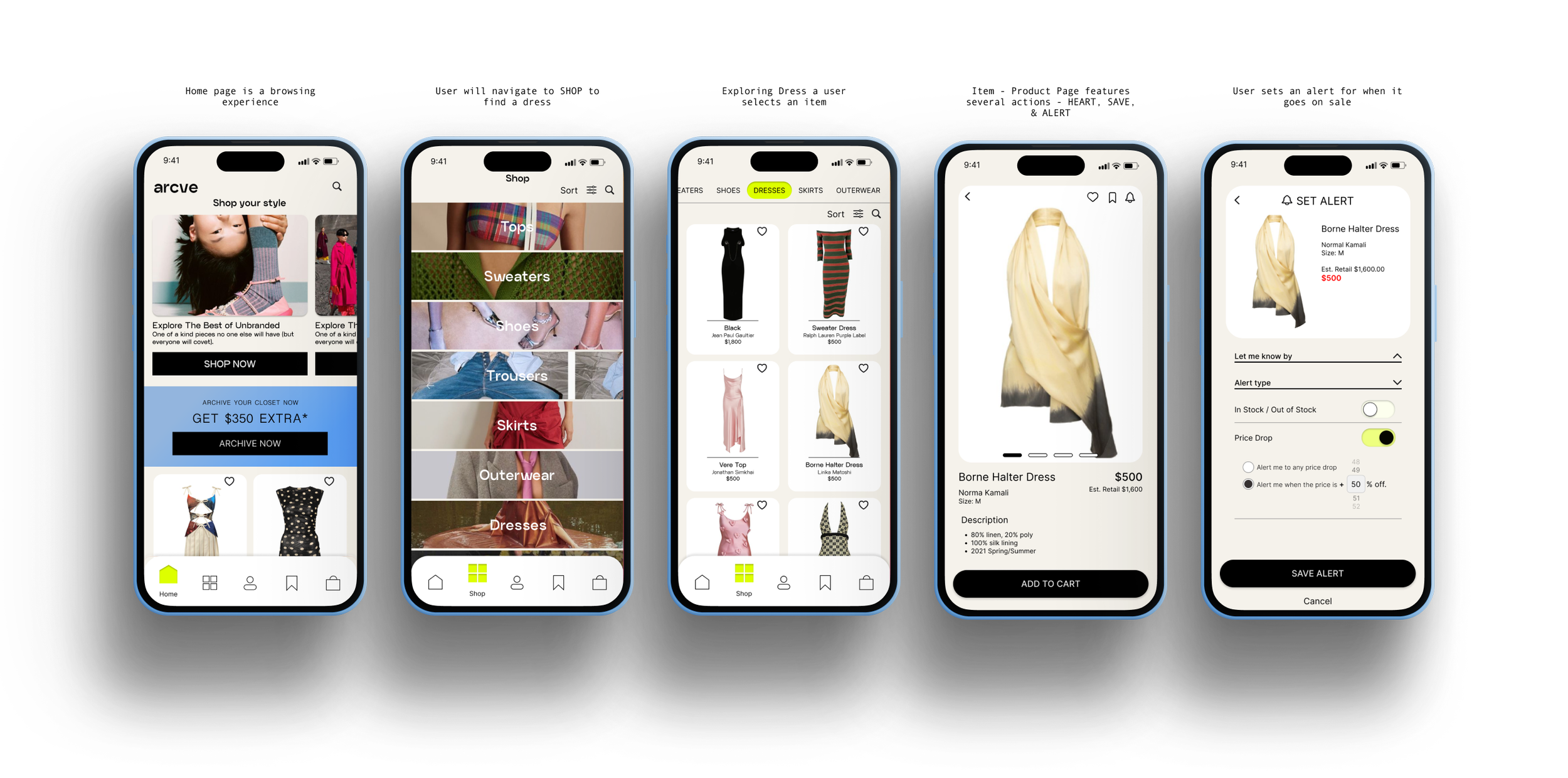


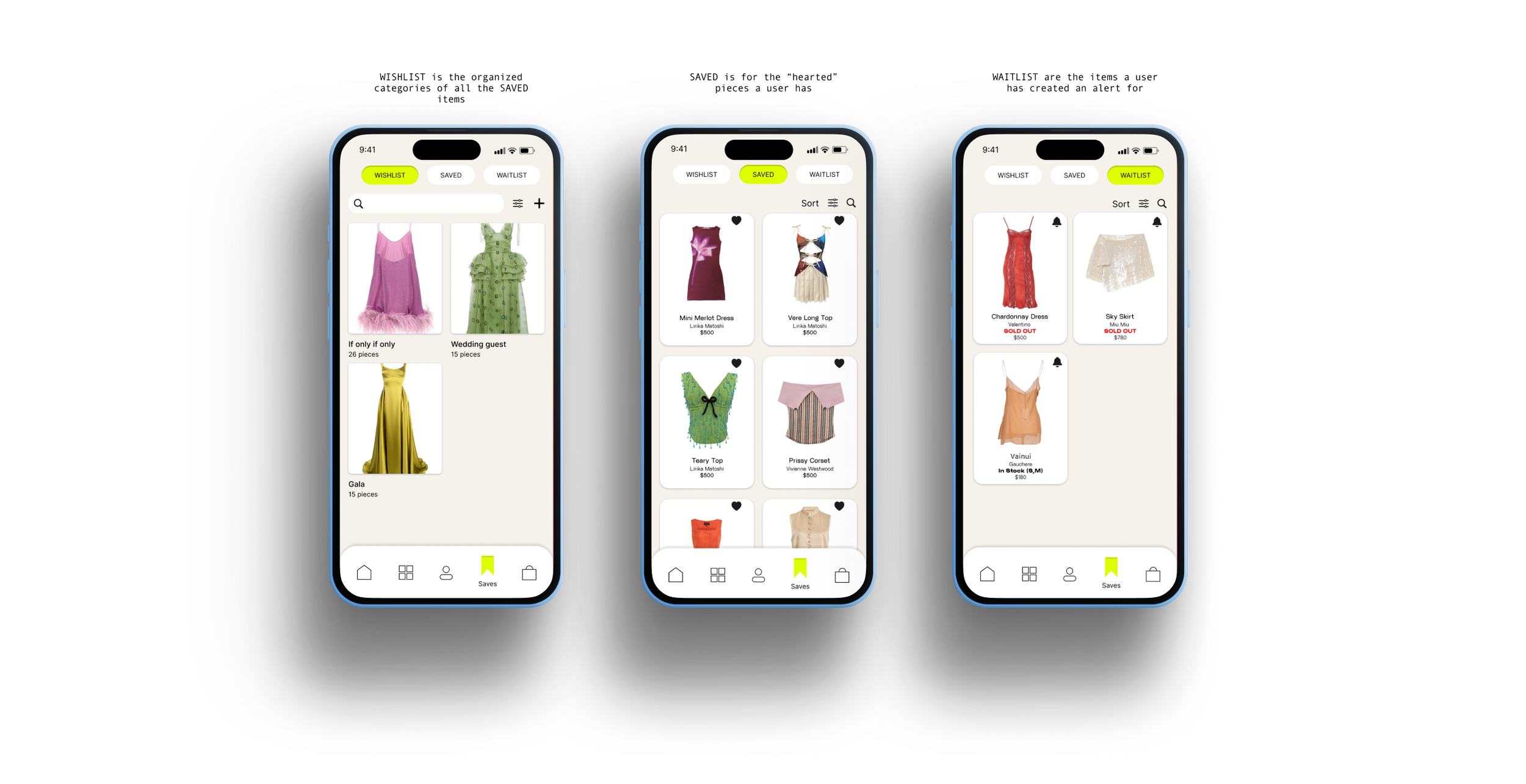
Final Thoughts
This project brought ARCVE from a vision to an immersive platform encouraging sustainable fashion choices. Beyond design, my work included in-depth market research, competitive analysis, and user persona development, creating a solid foundation for ARCVE’s unique positioning. Deliverables span a brand guideline, cohesive UI, high-fidelity prototypes, and validated user insights that refine the app’s core functionality. I’m excited about the final product’s nostalgic aesthetic and how it empowers users to embrace circular fashion. Future phases may expand item tracking, integrate social features, and enhance resale capabilities to increase ARCVE’s value as an all-in-one sustainable style tool.


